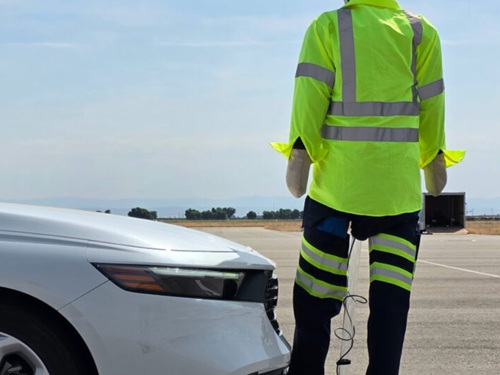A new report by AAA shows that vehicles equipped with pedestrian automatic emergency braking or PAEB systems witnessed a major improvement in nighttime impact avoidance from zero in 2019 to 60 percent in 2025; meaning that this technology is significantly reducing crashes between vehicles and pedestrians at night.
[Above photo by AAA]
AAA also investigated whether outfitting pedestrians with “high-visibility clothing” used by roadside assistance providers affected the performance of the PAEB systems tested. The impact of high-visibility clothing on PAEB systems varied under nighttime conditions, AAA’s researchers found – ranging from improved avoidance to a complete loss of detection.
According to the National Highway Traffic Safety Administration, in 2023, an estimated 7,314 pedestrians were killed in vehicle crashes, with more than 68,000 pedestrians injured in such crashes nationwide. Furthermore, the AAA Foundation for Traffic Safety analysis of data from the Emergency Responder Safety Institute found an average of 23 roadside assistance providers a year, including tow providers, were struck and killed by vehicles while working roadside in the years 2020-2024.

“Recent improvements in pedestrian automatic emergency braking systems are promising; however, there is still more work to be done,” noted Greg Brannon, AAA’s director of automotive engineering research, in a statement.
“Most pedestrian fatalities occur at night, and these systems can make a significant difference during those hours,” he said. “However, mixed performances with high-visibility clothing indicate that further refinement and testing are necessary to save more lives, including those of our roadside assistance providers.”
AAA conducted this research in partnership with the Automobile Club of Southern California’s Automotive Research Center; evaluating four vehicles equipped with PAEB technology on a closed course using a robotic pedestrian adult crossing in front of the test vehicles traveling at 25 mph.
Tests were conducted during the day and night with the adult pedestrian dressed in both standard non-reflective clothing as well as high-visibility apparel.
AAA noted that detection and response inconsistency poses ongoing risks to pedestrian safety, given that over 75 percent of pedestrian fatalities occur after dark. Recent findings from the AAA Foundation for Traffic Safety revealed pedestrian fatalities in the U.S. rose by over 80 percent in the past 15 years, with this increase occurring on urban arterial roads and after dark.
 Nation
Nation
The Stream by AASHTO: Electrified Roadway Testing
December 5, 2025 Nation
Nation

